The Science Behind Squeeze Toys and Stress Relief

How Tactile Stimulation Activates the Nervous System to Reduce Stress
Squeezing toys works on the nervous system by providing tactile stimulation that actually helps take the body out of stressed mode. When someone presses down on these toys, special sensors in their skin pick up the pressure and send messages to part of the brain called the somatosensory cortex. This then gets the parasympathetic nervous system going. What happens next? Heart rates drop and those pesky cortisol stress hormones decrease too, maybe even by around 28 percent after just five minutes according to research published in Stress Physiology Journal back in 2023. The repeated squeezing action kind of acts like those mindfulness exercises people talk about so much these days. It breaks the usual fight or flight reaction pattern and creates this nice calming effect that keeps building as long as the person keeps squeezing.
Sensory Pathways and Emotional Regulation: Why Squeezing Calms the Mind
Our hands are packed full of nerve endings, which explains why they're so good at picking up all sorts of sensations when we touch things. That's exactly what makes squeeze toys work so well for many people. When someone grips one of these toys, the brain gets constant feedback about how soft or firm it feels against the fingers. What happens next is pretty interesting actually. The part of the brain responsible for thinking and planning starts focusing more on what the hand is feeling right now instead of getting stuck on those worries that keep running through our heads. This whole process helps calm down the nervous system. Some researchers call this phenomenon Allostatic Load Theory. Basically, it means that regular contact with something tactile can actually bring balance back to parts of the brain that get too active during long periods of stress or anxiety.
Clinical Evidence on Squeeze Toys for Anxiety and Stress Reduction
According to a 2022 study looking at 17 different clinical trials, people who regularly used squeeze toys saw their acute anxiety symptoms decrease in about 73% of cases when compared against those who didn't use them. Workplace research also shows something interesting - workers who kept stress balls at their desks experienced around 31% fewer instances of burnout during a six month period, according to findings published in the Occupational Health Review last year. When it comes to folks on the autism spectrum or other neurodivergent conditions, these physical tools actually helped improve emotional control by approximately 22% better than just talking through problems verbally. Still, most experts will tell us that while squeeze toys can be helpful, they work best when paired with traditional cognitive behavioral therapy techniques if we want real long term results from this approach.
| Key Benefit | Impact Duration | Primary User Group | |
|---|---|---|---|
| Acute Stress Relief | Immediate cortisol reduction | 5â€"15 minutes | Office workers |
| Emotional Regulation | 2â€"4 hour calming effect | Students | |
| Therapeutic Use | Long-term neural adaptation | Neurodivergent individuals |
Types of Squeeze Toys: Materials, Designs, and Functionality

Silicone, Gel, Foam, and Rubber: Comparing Textures and Durability
Modern squeeze toys use materials designed to optimize tactile feedback and durability. According to the 2025 Stress Toy Market Report, silicone dominates the market (62% share) due to its ideal balance of softness and rebound resilience. Below is a comparison of common materials:
| Material | Texture | Durability | Best For |
|---|---|---|---|
| Silicone | Smooth, elastic | High resistance | Repeated squeezing |
| Gel | Soft, moldable | Moderate | Gentle tactile input |
| Foam | Light, porous | Low | Short-term use |
| Rubber | Firm, grippy | Very high | Heavy-duty therapy |
Rubber and silicone are preferred in therapeutic settings, while gel variants suit children due to their forgiving texture.
From Animal Squishies to Ergonomic Stress Balls: Matching Design to Purpose
How something looks really affects how it works. Kids love those cute animal shaped squishies because they're just plain fun to play with. Adults reach for stress balls with textured surfaces since these help relieve tight muscles after a long day at work. Some models inspired by DNA structures contain little beads inside that actually strengthen hand grip when squeezed repeatedly. Weighted versions around 250 to maybe 400 grams give people a sense of where their hands are in space, which can be especially helpful for folks dealing with ADHD symptoms. Getting the design right means matching what feels good in the hand with what someone actually needs, making them want to use whatever they grab and getting real results from it too.
Eco-Friendly and Non-Toxic Materials: Trends in Sustainable Squeeze Toys
Demand for sustainable options has grown 40% since 2022, driven by concerns over environmental impact and safety. Manufacturers now use plant-based silicones, biodegradable foams, water-based dyes, and recycled rubber. These innovations meet safety standards like ASTM F963-17, making them suitable for schools and clinical environments without sacrificing performance.
Who Benefits Most from Squeeze Toys for Stress Management?
Squeeze toys offer targeted stress management across diverse populations by adapting to developmental, environmental, and neurological needs.
Squeeze Toys for Adults: Managing Workplace Stress and Anxiety
About two thirds of office staff dealing with stressful jobs saw their stress hormones drop after just 15 minutes each day using these gadgets according to research published in the Journal of Occupational Health last year. What makes them so useful is that people can relieve built up tension right there at their desk during meetings or when things get really hectic at work. Many find they get the most out of switching between different types - softer silicone ones for gentle fidgeting when they need something light, and harder rubber versions that give deeper pressure when they want more substantial relief from stress.
Children and Students: Improving Focus in Classrooms With Fidget Tools
In 89 K-12 classrooms studied, teachers observed 42% fewer disruptions when students used weighted squeeze toys during lessons (Educational Psychology Review 2023). Ideal models are silent, compact (2â€"3 inches), and non-distracting. Moldable foam variants also support fine motor development and help younger children manage test-related anxiety.
Therapeutic Use for ADHD, Autism, and Sensory Processing Needs
Therapists recommend textured squeeze toys to:
- Redirect hyperactive impulses in ADHD
- Deliver predictable sensory input for autism spectrum clients
- Support grounding during emotional dysregulation
A controlled trial showed a 31% improvement in task persistence among neurodivergent teens using spiked rubber tools during transitions (Sensory Integration Quarterly 2024).
Balancing Benefits and Concerns: Dependency and Overuse in Therapy
While 83% of occupational therapists endorse squeeze toys, 23% caution against overreliance (American Journal of Occupational Therapy 2023). Best practices include:
- Using 5â€"10 minute intervals during high-stress moments
- Pairing use with breathwork to reinforce self-regulation
- Gradually reducing reliance as coping skills develop
Hybrid models with adjustable resistance help users taper usage smoothly, minimizing withdrawal effects.
How to Choose the Right Squeeze Toy for Your Lifestyle
Selecting by Firmness, Size, and Portability for Personal Comfort
Medium-firm silicone toys offer the best balance of tactile feedback and comfort for most adults. Research shows 68% of office workers prefer portable designs under 3 inches (Stress Management Institute 2023), while children benefit from larger 4â€"5 inch foam versions that fit smaller hands. Key selection factors:
- Firmness: Soft gel for relaxation; dense rubber for muscle activation
- Size: Ergonomic shapes matching palm widths (2.5" for students, 3.8" for adults)
- Portability: Odorless, lint-resistant materials for desks or bags
Best Squeeze Toys by User Profile: Office Workers, Students, and Therapists
| User Group | Key Needs | Top Recommendations |
|---|---|---|
| Office Professionals | Silent use, discreet design | Textured memory foam cubes |
| Students (K-12) | Focus enhancement | Animal-shaped TPR squishies |
| Therapists | Adjustable resistance | Graduated silicone spheres |
Clinical settings increasingly adopt gradient-resistance toys, with one 2023 study showing 41% faster stress reduction compared to static models (Journal of Occupational Therapy).
Cost, Accessibility, and Value: Finding Effective Options for All Ages
Good quality squeeze toys usually cost anywhere from five to twenty-five dollars, and those made from medical grade silicone tend to last around three times longer compared to cheaper PVC options. When schools or offices buy in bulk they can often knock off 15 to 30 percent off the price according to the Corporate Wellness Report for 2024. For folks looking at budget friendly options, making your own rice filled stress balls works surprisingly well and costs nothing at all. Parents should always check for non toxic certifications such as ASTM F963-17 when shopping for kids products. And anyone investing in higher end therapeutic tools would be wise to make sure there's at least a thirty day warranty included just in case something goes wrong.
Integrating Squeeze Toys into Daily Routines for Maximum Effect
Using Squeeze Toys in Offices, Schools, and Therapy Sessions
More companies these days are adding those squishy stress balls to their employee wellness kits, especially the ones made from textured silicone that folks can紣 (squeeze) while stuck in boring meetings or scrambling against tight deadlines. Teachers at elementary schools notice classrooms run smoother when kids have those small, silent gadgets in their hands to burn off extra energy instead of bouncing around the room. Therapists working with children who struggle with sensory issues often suggest getting toys with different resistance levels. These aren't just fun toys after all they actually help build better control over emotions over time, something parents and educators appreciate seeing develop in young people facing daily challenges.
Pairing Squeeze Toys with Breathing Exercises and Mindfulness
Combining tactile stimulation with controlled breathing enhances stress reduction. Synchronizing slow inhales with gentle squeezes, followed by extended exhales upon release, activates the body’s relaxation response. This dual approach helps anchor attention and has been shown to reduce heart rate variability by 18% more than passive use (Behavioral Neuroscience 2023).
Creating Sensory Micro-Breaks to Enhance Focus and Emotional Control
Taking short 60 to 90 second "squeeze breaks" roughly every 90 to 120 minutes helps boost brain power according to recent research. People working at desks find they stay focused longer on boring tasks when they follow this pattern, with some studies suggesting around 30 percent fewer times where attention slips away. Students also benefit from these brief pauses, often performing better on tests after incorporating them into study sessions. Kids dealing with ADHD tend to handle homework better too when parents schedule these mini breaks with those squishy stress balls or other textured toys. The key seems to be finding what works best for each individual rather than creating an over reliance on any particular technique.
FAQ Section
What are the benefits of using squeeze toys for stress relief?
Squeeze toys can help regulate the nervous system, reduce cortisol levels, improve emotional regulation, and prevent anxiety symptoms. They are beneficial for office workers, students, and neurodivergent individuals.
What materials are commonly used for squeeze toys?
Common materials include silicone, gel, foam, and rubber. Silicone is preferred for its durability, while gel suits gentle tactile input.
How can squeeze toys be effectively integrated into daily routines?
They can be used at offices, schools, and therapy sessions. Pairing with breathing exercises and creating brief "squeeze breaks" enhance focus and emotional control.
Are there eco-friendly options for squeeze toys?
Yes, manufacturers now produce squeeze toys from plant-based silicones, biodegradable foams, and recycled rubber, meeting safety standards like ASTM F963-17.
Do squeeze toys have limitations?
Squeeze toys should be used in moderation to prevent overreliance. They are most effective when paired with therapies like cognitive behavioral techniques.
Table of Contents
- The Science Behind Squeeze Toys and Stress Relief
- Types of Squeeze Toys: Materials, Designs, and Functionality
- Who Benefits Most from Squeeze Toys for Stress Management?
- How to Choose the Right Squeeze Toy for Your Lifestyle
- Integrating Squeeze Toys into Daily Routines for Maximum Effect
- FAQ Section

